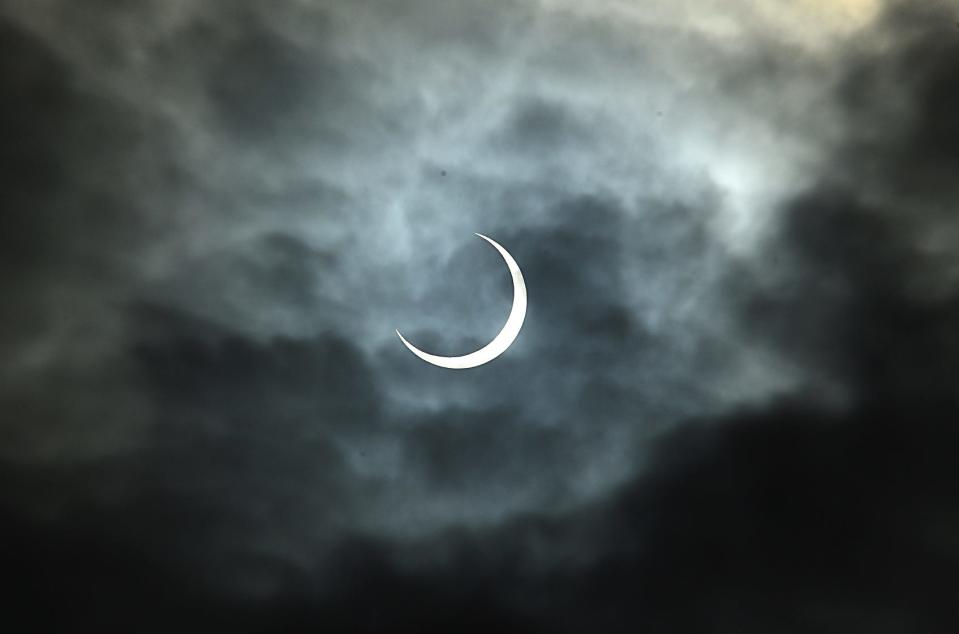Will it be cloudy for the April 8 total solar eclipse in Bloomington, Indiana?
Editor's note: This story represents the forecast from April 4. For the latest forecast, click here.
As many as 300,000 tourists are expected to visit Bloomington on April 8 for the total solar eclipse, but the weather forecast for the big day is casting a long shadow on the event. Four days out from the eclipse, the Monday forecast still looks cloudy, with 70% cloud cover expected for the afternoon.
But don't cancel your eclipse plans just yet; eclipses are rare events that can still be seen through high, thin clouds, and can even cause cumulus clouds to dissipate as temperatures drop closer to totality.
Here's what to know about the weather forecast for the eclipse.
Pre-eclipse things to do: Have fun and learn about the eclipse at these events this weekend in Bloomington
What is the latest forecast for the eclipse in Bloomington, Indiana?
The forecast has been trending in a positive direction in the past few days, with the National Weather Service (NWS) in Indianapolis predicting "mostly sunny" weather with highs in the 70s.
Aaron Updike, a meteorologist at NWS Indianapolis, said cloud cover is still expected throughout the Midwest. But, he said, it is difficult to know what kind of cloud cover Bloomington will get until a day or two before the eclipse. He noted a low-pressure system is coming to the Midwest from the west, which could have a major impact on cloud cover.
"When we say cloud cover, we're not very specific," Updike said. "We're seeing what looks like a low-pressure system approaching late this weekend into Monday, and depending on where that's located, it can create a big difference in cloud cover. There are so many small-scale influences that go into the clouds that we see, so it'll be difficult to know until closer to the event."
Will I be able to see the eclipse in Bloomington if it's cloudy?
That depends on what kind of cloud cover Bloomington has during the eclipse.

NASA's Earth Observatory notes cloud shape and density can have a major impact on eclipse visibility. If Bloomington and Monroe County have mostly thin cirrus clouds in the upper atmosphere, for example, it's likely the sun itself and the eclipse's effect on the sky will be mostly visible. If Bloomington has thick, low storm clouds, it's unlikely that totality will be visible – though the eclipse's dusky effect on the sky should still be somewhat perceptible.
Can eclipses cause clouds to part?
It depends. Research has found certain clouds, particularly shallow cumulus clouds, tend to dissipate as totality begins and land surface temperatures start to cool. This can happen early on in totality, when just 15% of the sun is covered, meaning we could get a better idea of eclipse visibility in the hour leading up to totality.
Will it get colder during the eclipse?
Yes. As the moon begins to cover the sun, temperatures can drop as much as 10 degrees, according to the National Weather Service. Temperatures begin to drop 30 to 60 minutes before totality.
Temperature drops can vary across geography; across Kentucky, temperatures dropped anywhere between 4 to 10 degrees during the 2017 solar eclipse.
Is the forecast any sunnier in other parts of Indiana?
Not really. The NWS' map on sky cover for April 8 shows cloud cover getting worse the further northeast you go, like in Muncie and Richmond. Clouds do look slightly calmer in western Illinois and Missouri, but if you're looking for a half-decent chance to see the eclipse within a reasonable distance, it might be best to just stay here in Bloomington.
Reach Brian Rosenzweig at brian@heraldt.com.
This article originally appeared on The Herald-Times: Bloomington, Indiana weather prediction for 2024 solar eclipse April 8

